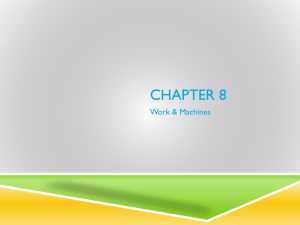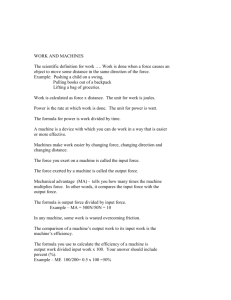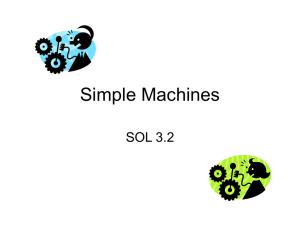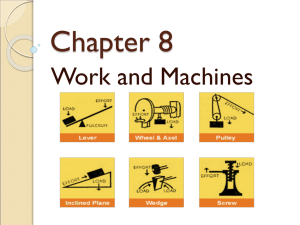Chapter 8
advertisement
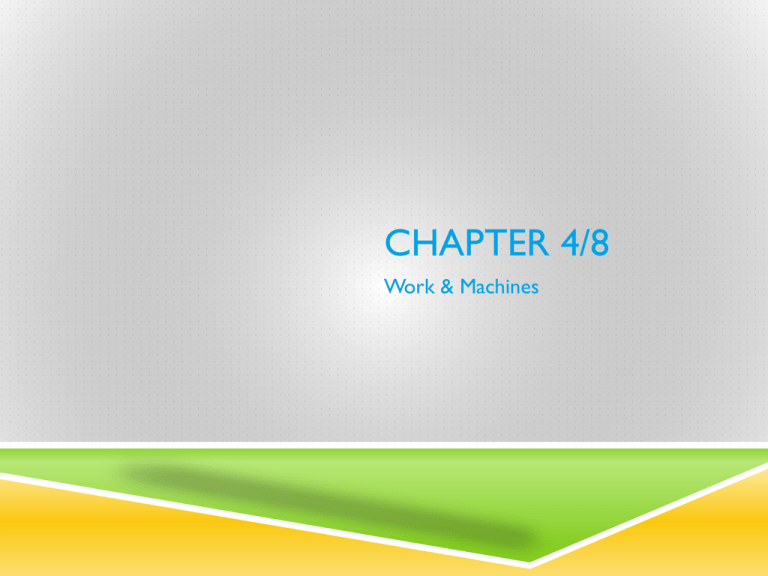
CHAPTER 4/8 Work & Machines WHAT IS WORK? Work is done when a force causes an object to move in the direction of the force. Transfer of kinetic energy Applying a force does NOT always result in work being done. If you apply a force to an object and it doesn’t move, no work was done. If the applied force is not in the same direction as the movement of the object NO work is done. IS WORK BEING DONE? http://www.cbsnews.com/video/ watch/?id=50138922n HOW MUCH WORK? Work depends on force as well as distance. Would you do more work by hiking up the hill or climbing up the side of the cliff? d1 d2 F2 F1 Because the climber ends up the same place, the same amount of work is done. The hiker goes a shorter distance climbing the cliff but uses more force. The hiker goes a longer distance but uses less force hiking up the hill. CALCULATING WORK Work Joule (J) Force (N) Newton (N) Distance Meters (m) (m) Joule – the unit used to express energy; equivalent to the amount of work done by a force of 1 N acting through a distance of 1 m in the direction of the force WORK PRACTICE PROBLEMS Using a force of 10 N, you push a shopping cart 10m. How much work did you do? You use 75 N of force to push a box 3 m across the floor. How much work has been done? Lifting a dog 2 m off the ground requires 12 J of work. How much force was required? POWER: HOW FAST WORK IS BEING DONE Power- the rate at which work is done or energy is transformed Watt- the unit used to express power; equivalent to joules per second Increasing Power Do more work in a given time Do the same work in less time POWER PRACTICE PROBLEMS A stage manager at a play raises a curtain by doing 5,976 J of work on the curtain in 12 s. What is the power output of the stage manager? If it takes you 10 s to do 150 J of work on a box to move it up a ramp, what is your power output? POWER PRACTICE PROBLEMS A light bulb is on for 12 s, and during that time, it uses 1,200 J of electrical energy. What is the power (wattage) of the light bulb? You and a friend together apply a force of 1,000 N to a car, which makes the car roll 10 m in 90 s. How much work did you and your friend do together? What was the power output? 8.2 WHAT IS A MACHINE Machine- A device that makes work easier by changing the size or direction of a force. Work in, work out Work Input- the work that you do on a machine. You apply a force, called the input force, to the machine through a distance. Work Output- the work a machine applies through a force, called the output force, through a distance. Work output can NEVER be greater than work input!!! HOW MACHINES HELP Look at the picture of the paint can and screw driver: Work done by screwdriver on lid = work you do on screwdriver (Work output can never be greater than work input.) Machines allow force to be applied over a greater distance, which means that less force will be needed for the same amount of work. FORCE DISTANCE TRADE OFF When force or distance decreases, the other must increase. Greater force, less distance Less force, greater distance MECHANICAL ADVANTAGE Mechanical Advantage - The number of times the machine multiplies force. Calculating Mechanical Advantage Mechanical advantage equals the output force divided by the input force. output force Mechanical advantage (MA) input force MECHANICAL ADVANTAGE PROBLEMS A grocer uses a handcart to lift a heavy stack of canned food. Suppose he applies an input force of 40 N to the handcart. The cart applies an output force of 320 N to the stack of canned food. What is the mechanical advantage of the handcart? A pulley is being used to lift a dresser to the 2nd floor of a building. Suppose a input force of 30 N is applied to the pulley. The pulley applies an output force of 150 N to the dresser. What is the mechanical advantage of the pulley? MECHANICAL EFFICIENCY The output of a machine is always less than the work input. Why?? Some of the work done by the machine is used to overcome the friction created by the use of the machine. The less work a machine has to do to overcome friction, the more efficient the machine is. Calculating Efficiency Mechanical Efficiency equals work output divided by work input multiplied by 100. Efficiency = workoutput 100 workinput MECHANICAL EFFICIENCY PROBLEMS What is the mechanical efficiency of a machine whose work input is 100 J and work output is 30 J? What is a machines mechanical efficiency who work input is 150 J and work output is 100 J? SIMPLE MACHINES Levers Pulleys Wheel and Axles Inclined Planes Wedges Screws Compound Machines LEVERS A simple machine that consist of a bar that pivots at a fixed point called a fulcrum. There are 3 classes of levers – depend on the location of the fulcrum, the load, and the input force. LEVERS First-Class Levers The fulcrum is between the input force and the load. LEVERS Second-Class Levers The load of a second-class lever is between the fulcrum and the input force. LEVERS Third-Class Levers The input force in a third-class lever is between the fulcrum and the load. PULLEY Pulley- a simple machine that consists of a wheel over which a rope, chain, or wire passes PULLEY • Fixed Pulley - Attached to something that does not move. You pull down on the rope to lift the load upward. The pulley changes the direction of the load. Ex • Moveable Pulley- Attached to the object being moved. Does not change the force’s direction. Increase input force Ex PULLEY Block & Tackle Pulley - A fixed and moveable pulley are used together. Mechanical advantage of the block and tackle depend on the number of wheels. WHEEL & AXEL A wheel and axle is a simple machine consisting of two circular objects of different sizes. Mechanical Advantage = radius of wheel/radius of axel MECHANICAL ADVANTAGE OF A WHEEL & AXEL What is the mechanical advantage of a wheel and axel when the radius of the wheel is 100 cm and the radius of the axel is 10 cm? What is the mechanical advantage of a wheel and axel when the radius of the wheel is 75 cm and the radius of the axel is 15 cm? INCLINED PLANES Simplest of all the machines. Common inclined planes: Ramp Wedge screw Compound Machines Compound machines are machines that are made of two or more simple machines. Mechanical Efficiency Low because compound machines have more moving parts than simple machines do, thus there is more friction to overcome What simple machines are found in a bike?
